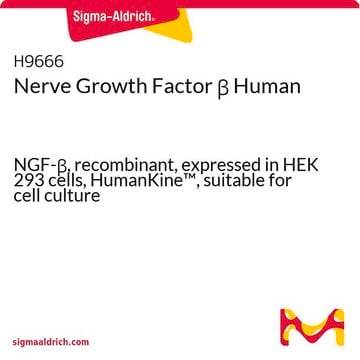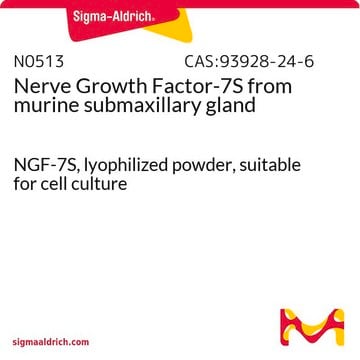N8133
Nerve Growth Factor from Vipera lebetina venom
NGF, lyophilized powder, suitable for cell culture
Sign Into View Organizational & Contract Pricing
All Photos(1)
About This Item
Recommended Products
biological source
Vipera Lebetina
Quality Level
form
lyophilized powder
potency
0.2-20 μg/mL ED50/EC50
quality
endotoxin tested
mol wt
protein 32.5 kDa
packaging
pkg of 0.1 mg
technique(s)
cell culture | mammalian: suitable
impurities
<10 EU/vial
color
white to off-white
UniProt accession no.
storage temp.
−20°C
Physical form
Lyophilized from a 0.2 μm filtered solution in sodium acetate buffer.
Preparation Note
Isolated from the snake venom of V. lebetina.
Analysis Note
The biological activity of Nerve Growth Factor (NGF) from Vipera lebetina venom is measured in a cell proliferation assay using PC-12 cells.
Storage Class Code
11 - Combustible Solids
WGK
WGK 3
Flash Point(F)
Not applicable
Flash Point(C)
Not applicable
Personal Protective Equipment
dust mask type N95 (US), Eyeshields, Gloves
Certificates of Analysis (COA)
Search for Certificates of Analysis (COA) by entering the products Lot/Batch Number. Lot and Batch Numbers can be found on a product’s label following the words ‘Lot’ or ‘Batch’.
Already Own This Product?
Find documentation for the products that you have recently purchased in the Document Library.
Customers Also Viewed
Lucy Hepburn et al.
Science (New York, N.Y.), 346(6209), 641-646 (2014-11-02)
Many key components of innate immunity to infection are shared between Drosophila and humans. However, the fly Toll ligand Spaetzle is not thought to have a vertebrate equivalent. We have found that the structurally related cystine-knot protein, nerve growth factor
Giusi Prencipe et al.
Journal of immunology (Baltimore, Md. : 1950), 192(7), 3345-3354 (2014-03-04)
Nerve growth factor (NGF) levels are highly increased in inflamed tissues, but their role is unclear. We show that NGF is part of a regulatory loop in monocytes: inflammatory stimuli, while activating a proinflammatory response through TLRs, upregulate the expression
Yu-Jung Chang et al.
Biochimica et biophysica acta, 1830(8), 4130-4136 (2013-04-16)
Neurotrophins are important regulators for neural development and regeneration. Nerve growth factor (NGF) therapy has been tested in various models of neural injury and degeneration. However, whether NGF can reach target tissues and maintain effective concentration for a certain period
Tao Yu et al.
The Journal of neuroscience : the official journal of the Society for Neuroscience, 34(17), 6098-6106 (2014-04-25)
Trk neurotrophin receptor ubiquitination in response to ligand activation regulates signaling, trafficking, and degradation of the receptors. However, the in vivo consequences of Trk ubiquitination remain to be addressed. We have developed a mouse model with a mutation in the
M Florencia Iulita et al.
Trends in pharmacological sciences, 35(7), 338-348 (2014-06-26)
Alzheimer's disease (AD) is a devastating neurodegenerative condition and the most common type of amnestic dementia in the elderly. Individuals with Down syndrome (DS) are at increased risk of developing AD in adulthood as a result of chromosome 21 trisomy
Our team of scientists has experience in all areas of research including Life Science, Material Science, Chemical Synthesis, Chromatography, Analytical and many others.
Contact Technical Service







